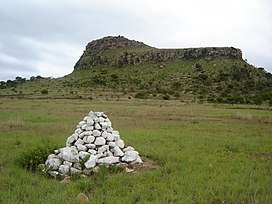Isandlwana
| Isandlwana | |
|---|---|
 Isandlwana with a British cairn marking a grave from the Battle of Isandlwana | |
| Highest point | |
| Elevation | 1,284 m (4,213 ft)[1] |
| Listing | List of mountains in South Africa |
| Coordinates | 28°21′7″S 30°39′6″E / 28.35194°S 30.65167°E |
| Geography | |
| Location | KwaZulu-Natal |
| Parent range | Drakensberg foothill |
| Climbing | |
| First ascent | Unknown |
| Easiest route | From Dundee |
Isandlwana (Zulu pronunciation: [ísanˈdɮwáːna])[2] (older spelling Isandhlwana, also sometimes seen as Isandula) is an isolated hill in the KwaZulu-Natal province of South Africa. It is located 169 kilometres (105 mi) north by northwest of Durban.[3] The name is said to mean abomasum, the second stomach of the cow, because it reminded the Zulus of its shape.
History
This mountain has historical significance. On 22 January 1879, Isandlwana was the site of the Battle of Isandlwana, where approximately 22,000 Zulu warriors defeated a contingent of approximately 1,350 British and Native troops in one of the first engagements of the Anglo-Zulu War.[4] The force was largely wiped out by the Zulus under Ntshingwayo kaMahole Khoza. The battle remains the single greatest defeat for the British Army at the hands of a native army.[5]
Isandlwana hill rises 16 kilometres (10 mi) Northeast of Rorke's Drift, a ford on the Buffalo River, a tributary of the Tugela River.
See also
- Battle of Isandlwana
- List of mountains in South Africa
- SAS Isandlwana (F146) - a Valour-class frigate of the South African Navy
References
- ^ Google Earth
- ^ John Wells: the symbol ɮ. John Wells's phonetic blog, 19. September 2012.
- ^ Encyclopædia Britannica (1950), v.12, 703.
- ^ BritishBattles.com "The Battle of Isandlwana"
- ^ The Battle of Isandlwana
External links

